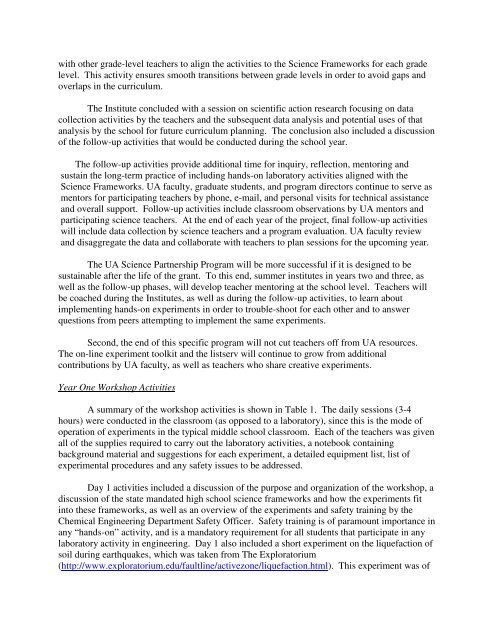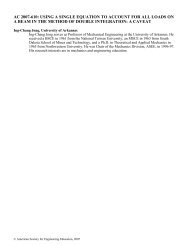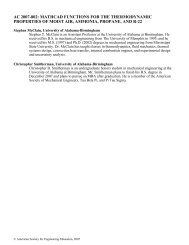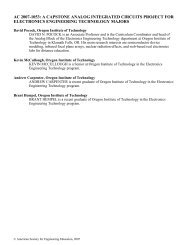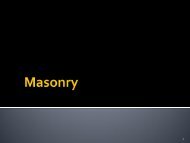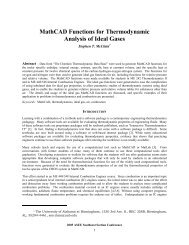AC 2007-514: UNIVERSITY OF ARKANSAS SCIENCE ...
AC 2007-514: UNIVERSITY OF ARKANSAS SCIENCE ...
AC 2007-514: UNIVERSITY OF ARKANSAS SCIENCE ...
Create successful ePaper yourself
Turn your PDF publications into a flip-book with our unique Google optimized e-Paper software.
with other grade-level teachers to align the activities to the Science Frameworks for each grade<br />
level. This activity ensures smooth transitions between grade levels in order to avoid gaps and<br />
overlaps in the curriculum.<br />
The Institute concluded with a session on scientific action research focusing on data<br />
collection activities by the teachers and the subsequent data analysis and potential uses of that<br />
analysis by the school for future curriculum planning. The conclusion also included a discussion<br />
of the follow-up activities that would be conducted during the school year.<br />
The follow-up activities provide additional time for inquiry, reflection, mentoring and<br />
sustain the long-term practice of including hands-on laboratory activities aligned with the<br />
Science Frameworks. UA faculty, graduate students, and program directors continue to serve as<br />
mentors for participating teachers by phone, e-mail, and personal visits for technical assistance<br />
and overall support. Follow-up activities include classroom observations by UA mentors and<br />
participating science teachers. At the end of each year of the project, final follow-up activities<br />
will include data collection by science teachers and a program evaluation. UA faculty review<br />
and disaggregate the data and collaborate with teachers to plan sessions for the upcoming year.<br />
The UA Science Partnership Program will be more successful if it is designed to be<br />
sustainable after the life of the grant. To this end, summer institutes in years two and three, as<br />
well as the follow-up phases, will develop teacher mentoring at the school level. Teachers will<br />
be coached during the Institutes, as well as during the follow-up activities, to learn about<br />
implementing hands-on experiments in order to trouble-shoot for each other and to answer<br />
questions from peers attempting to implement the same experiments.<br />
Second, the end of this specific program will not cut teachers off from UA resources.<br />
The on-line experiment toolkit and the listserv will continue to grow from additional<br />
contributions by UA faculty, as well as teachers who share creative experiments.<br />
Year One Workshop Activities<br />
A summary of the workshop activities is shown in Table 1. The daily sessions (3-4<br />
hours) were conducted in the classroom (as opposed to a laboratory), since this is the mode of<br />
operation of experiments in the typical middle school classroom. Each of the teachers was given<br />
all of the supplies required to carry out the laboratory activities, a notebook containing<br />
background material and suggestions for each experiment, a detailed equipment list, list of<br />
experimental procedures and any safety issues to be addressed.<br />
Day 1 activities included a discussion of the purpose and organization of the workshop, a<br />
discussion of the state mandated high school science frameworks and how the experiments fit<br />
into these frameworks, as well as an overview of the experiments and safety training by the<br />
Chemical Engineering Department Safety Officer. Safety training is of paramount importance in<br />
any “hands-on” activity, and is a mandatory requirement for all students that participate in any<br />
laboratory activity in engineering. Day 1 also included a short experiment on the liquefaction of<br />
soil during earthquakes, which was taken from The Exploratorium<br />
(http://www.exploratorium.edu/faultline/activezone/liquefaction.html). This experiment was of


